Last Updated on April 27, 2023
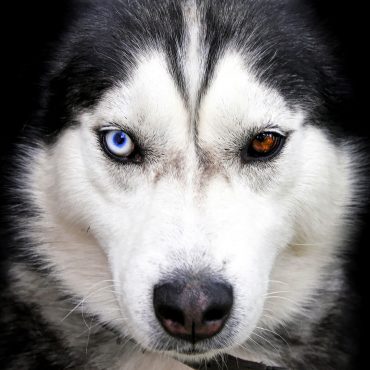
He’s woolly, and he’s talkative, he’s…a Siberian Husky!
Called Huskies for short (though aficionados prefer Siberian), these canines are well-known for their passionate singing and have no problem speaking their mind.
Some people mistakenly think that Siberian Huskies are aggressive, but they’re really just enthusiastic. Let’s clear up all those pesky misconceptions so you can get to know the Husky’s true nature.
Quick Navigation
- 1 Where Did the Siberian Husky Originate?
- 2 What Does a Siberian Husky Look Like?
- 3 Temperament: What is special about Siberian Husky dogs?
- 4 How to Take Care of Your Siberian Husky Dogs?
- 5 Siberian Husky lifespan: How long do they live?
- 6 How Much is a Siberian Husky Puppy?
- 7 If you’re interested in Siberian Husky mixes…
- 8 Who Should Get a Siberian Husky Dog?
- 9 Further Reading: Breeds similar to the Siberian Husky
Where Did the Siberian Husky Originate?
Part of the Spitz canine family, DNA tests have proven that Huskies are one of the oldest dog breeds in existence.
We can trace their lineage back to Siberia in northeastern Asia, where the Chukchi people bred them as working companions.
The nomadic Chukchi needed a dog that could pull loads across the tundra. This fido has to be strong, with grit and fortitude. It also needed to be friendly and warm–a dedicated member of the pack.
The Chukchi’s sled dog gave way to the modern Siberian Husky. By the early 1900s, Huskies made their way to North America–to Alaska, to be more specific, during the Gold Rush.
Perhaps the most prominent sled race in the United States, the All-Alaska Sweepstakes, catapulted the Siberian Husky to sled dog fame.
Mushers and their sledding teams traversed a 408-mile-long route competing to see who could cover this long distance the fastest.
Even though the Sweepstakes were discontinued in 1917 during World War I, Siberian Huskies would again be called upon to put their stamina and sledding skills to noble use.
In 1925, a Siberian Husky sled relay covered 658 miles of arctic terrain in less than a week to deliver life-saving diphtheria medication to Nome, Alaska.
Known as the “serum run,” that fantastic feat solidified the Husky’s place in America’s heart. The lead dog on the run’s final leg, Balto, even got his own statue in New York City’s Central Park later that year.
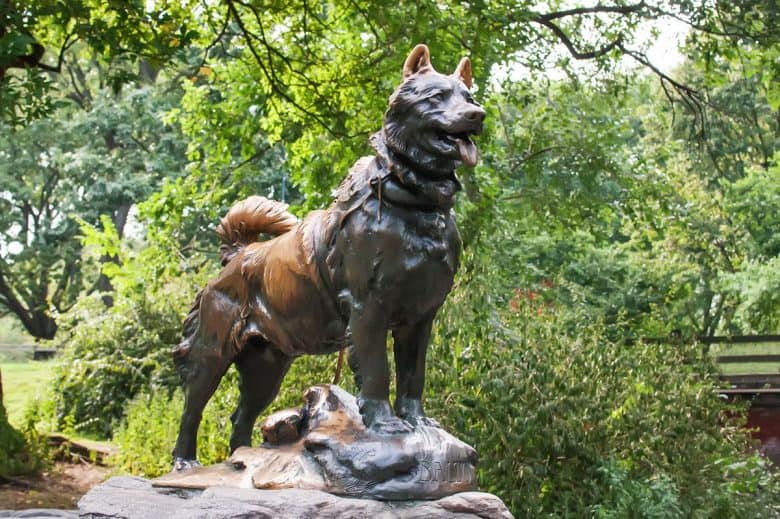
The American Kennel Club (AKC) officially recognized the Siberian Husky just five years after the run, in 1930. The United Kennel Club (UKC) followed suit in 1938.
What Does a Siberian Husky Look Like?
The “Husky” in Siberian Husky is a bit misleading. It implies that these doggos are big burly when they’re actually graceful and sleek.
According to the AKC breed standard, the Husky’s eye colors which can be brown, blue, or both, are set slightly apart in their rounded skull.
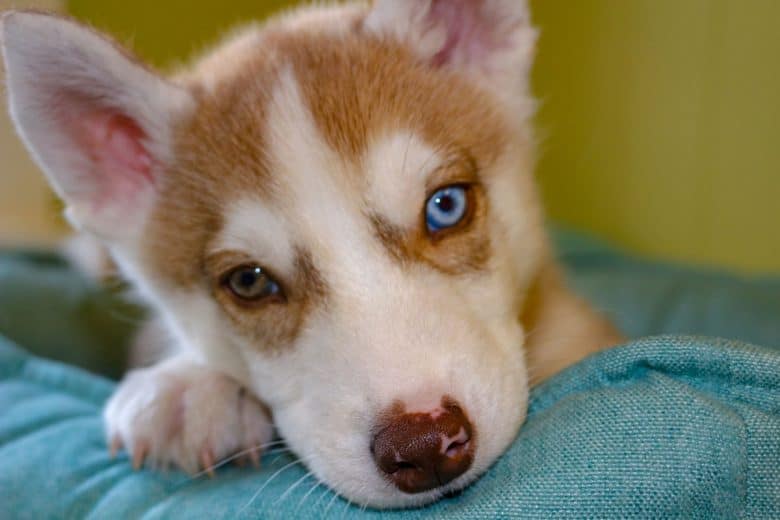
They have a mischievous yet kind expression, speaking to their spunky yet sweet nature. Their fluffy, medium-sized ears point straight up – a direct contrast to their tapered muzzle.
The Siberian Husky’s neck is muscular but not overly stocky. Their chest is deep, though not so much to be considered barrel-chested. And their back is strong, straight, and level.
Moving to the Husky’s forequarters and hind legs, you’ll notice that the elbows hold close to the body. The front legs are mostly straight, with the upper arm bending ever so slightly.
The Husky’s back legs are muscular with a distinct slant. Her paws should be oval-shaped and sturdy, with a generous amount of fuzz between the toes.
This purebred is mostly adored for their wolf-like appearance. Their long history as a durable sled-puller couldn’t be more evident than in their bone structure and conformation.
Don’t miss out: Malamute vs Husky: What’s the difference?
How big do Siberian Huskies get?

Surprisingly, a full-grown Siberian Husky isn’t as large as some people think. There’s not much difference in size between genders, either.
The average male Husky will stand 21 to 23.5 inches (53 to 60 cm) tall and weigh 45 to 60 pounds (20 to 27 kg).
Females measure 20 to 22 inches (51 to 56 cm) at the withers and usually weigh 35 to 50 pounds (16 to 23 kg).
Of course, you could go even smaller and get a Miniature Husky. These little guys top out at 12 to 17 inches (30 to 43 cm) and 15 to 35 pounds (7 to 16 kg).
Mini Huskies are about half the size of a standard Husky, so some owners may find them easier to manage.
Just keep in mind that miniature pups can be at greater risk for health problems. Weigh your options carefully (no pun intended).
While the Husky’s medium size can work for apartment living, their energetic spirit and tendency to vocalize makes them better candidates for single-family homes with large yards.
Don’t miss out: Comprehensive Siberian Husky Growth and Weight Chart
The Siberian Husky’s coat and color
Siberian Huskies come outfitted with a thick, straight, double coat. Their two-layered fur keeps them warm even in the lowest of temperatures–right on down to -58° to -76° F (-50° to -60° C).
Some Huskies have the standard, medium-length coat. Others have a longer fur, dubbed the woolly coat, which is caused by a recessive gene, and therefore isn’t considered typical of the breed.
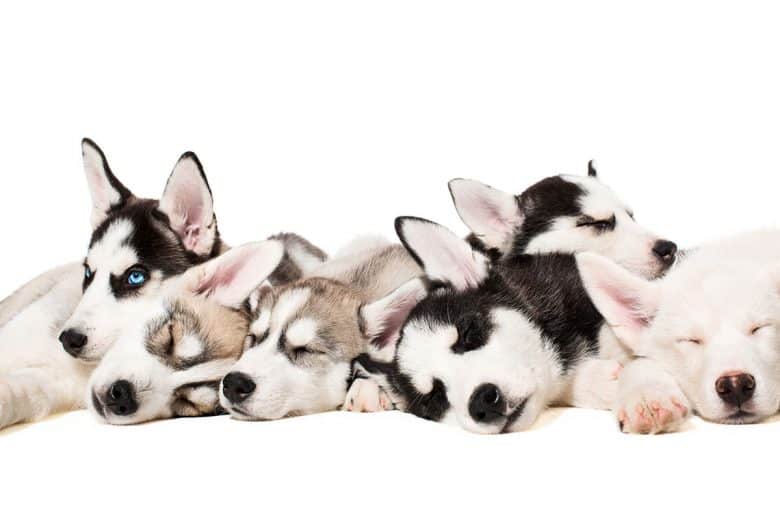 Most Huskies have white masks on their faces and white fur on their bellies, with another darker color on the rest of the body.
Most Huskies have white masks on their faces and white fur on their bellies, with another darker color on the rest of the body.
You’ve likely seen Siberians with black and white color patterns. But they come in many other coat combinations, as well.
In addition to black, you’ll also see grey and white, red and white, sable and white, and Agouti Husky. (Agouti fur has two or more pigments in the same strand).
It gives the appearance of speckled, salt-and-pepper hair.) You may even spot a pure white Husky with a coat like furry snow!
You’ll also see Huskies with black points or black around the eyes, paws, and nose. Others have piebald markings.
Piebald Huskies look totally different from the characteristic Siberian. They’re mostly white, with large splotches of another color randomly sprinkled across their bodies.
No matter which color pattern your Husky ends up with, they’re guaranteed to be both gorgeous and fluffy.
Don’t miss out: Everything you need to know about Siberian Husky colors
Temperament: What is special about Siberian Husky dogs?
There’s a misconception floating around that Siberian Huskies aren’t good family pets. That couldn’t be any further from the truth.
Huskies were bred to pull sleds and cozy up to their humans after a hard day’s work. In fact, they’re so friendly that they make terrible watchdogs.
Rather than frighten them away, your Husky would probably welcome an intruder into your home for a game of tug.
Is a Siberian Husky dangerous?
Some say that this purebred is one of the most dangerous dogs out there. But as with all doggies, you should still plan to supervise playtime with the kiddos.
Younger children, in particular, could play a little too roughly or be too small to withstand your Husky’s high energy.
Whatever you do, don’t let your Siberian loose around cats. Or hamsters. Or gerbils. (Do you see a pattern here?)
The Husky’s high prey drive may well exceed their natural enthusiasm. If your pack includes small animals, reconsider bringing a Husky into the fold.
Keep in mind that an intact prey drive is NOT the same as aggression. Hunting and chasing are instinctive reflexes for dogs, no matter how domesticated they seem.
Do you know what else is instinctive for your Husky? Talking.
They talk when they’re happy, mad, and even when their humans won’t turn on the faucet so they can play in the bathtub, like good boy Zeus in this video:
This howling behavior is a carryover from their wolf ancestry. It’s how Siberian Huskies communicate with people and animals alike.
Interestingly, Huskies don’t bark much, but they’ll howl their heads off. If you need a quiet dog, you won’t find it in a Husky.
You also won’t find a teacher’s pet in your Siberian. Now don’t get us wrong. These dogs are smart as a whip, but they’re not people-pleasers.
Yes, Huskies are as hard to train as you’ve heard. For this reason, we only suggest Husky ownership for veteran dog owners. They need a firm handler, one who’s mastered “benevolent alpha” leadership.
Be honest with yourself about how you maintain authority in your pack. Too heavy-handed, and your Husky will resent you. Too wishy-washy, and your Husky will play you like a fiddle.
It truly is a delicate balance. Be forewarned, though. Even the most experienced dog moms and dads will have their hands full with this precocious breed.
Born with a strong independent streak and a passion for mischief, your Siberian Husky will find misbehaving to be far more entertaining than obeying.
Don’t be surprised if they earn top marks in obedience class and miraculously “forget” everything they know when it counts.
Recall training, in particular, is challenging for Huskies to master.
Because of their wily ways, we don’t recommend letting your Husky off-leash. Their prey drive and free-spirited tendencies make their recall unreliable at best. This is especially true if they aren’t properly exercised.
Not only are Huskies prone to boredom, but that constant need for stimulation leads them to create their own fun. That might mean volunteering you for a game of chase around the doggy park.
It could also mean going Incredible Hulk (Incredible Husky?) on your furniture.
We all know that a bored dog can be destructive, but Huskies take it to a whole new level. Have you ever done a YouTube search for “husky destroys couch”?
When you do, you’ll see why tiring out your Siberian Husky should be a top priority.
In addition to using exercise and brain games to keep your Husky under control, you might want to consider crate training for when you leave the house.
Some Huskies show signs of separation anxiety when left alone. This panic combined with their natural restlessness–and zero humanly oversight–can spell major trouble.
In many of those YouTube videos, you’ll notice that the Siberians in question went on their rampages when their owners were away.
Teaching your Husky that the crate is their safe space, and not a punishment can prevent your home from becoming a disaster zone.
That said, a Husky-proof crate will be difficult to come by. Siberians are tried-and-true escape artists. You see a secure crate, and they see a puzzle.
You see a tie-out, and they see a challenge. You see a fence, and they see a double dare.
Some Husky lovers recommend that outside fencing be just as deep as it is tall. Huskies are good diggers, and they’ve been known to tunnel their way out of enclosures.
Don’t believe us? Just watch Loki and Cudos in this video tag-team their great escape. Siberian Huskies? Maybe they should’ve been called Siberian Houdinis.
When it’s all said and done, the Siberian Husky could be the most exceptional dog you’ll ever own. They’ll certainly be the most memorable, but you want to be sure they’re unforgettable for the right reasons.
Prevention and proactivity are essential to giving Huskies a good quality of life. If you plan on getting a cat or already have one, don’t get a Husky.
If you know you can’t resist a set of sea-blue puppy dog eyes, don’t get a Husky.
But if you’re up for an adventure, you’re a dog lover through and through, and you’ve got a slew of well-trained doggos under your belt, you should probably get a Siberian Husky of your own.
How to Take Care of Your Siberian Husky Dogs?
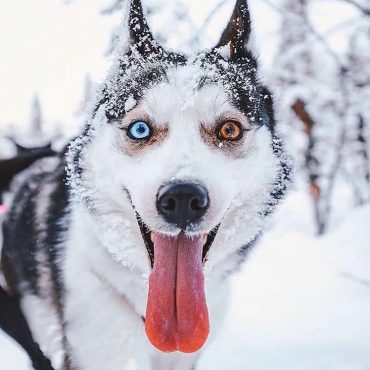 If you’re starting to think that Siberian Huskies are high-maintenance, you’re right. These exuberant family pets, with their thick coats, require plenty of companionship and upkeep.
If you’re starting to think that Siberian Huskies are high-maintenance, you’re right. These exuberant family pets, with their thick coats, require plenty of companionship and upkeep.
How much attention they need can vary with the seasons, however.
Designed to withstand freezing temperatures, Huskies are much more tolerant of cold weather than other breeds.
When temperatures rise, say goodbye to strenuous outdoor exercise! And say hello to ramped-up grooming.
Exercising your Siberian Husky
As a working dog with a high energy level, the Husky needs both physical and mental exercise. Aim for 30 to 60 minutes at the very least.
Remember that off-leash exercise in unsecured areas is not a good idea. Playing fetch at the dog park sounds like a fun afternoon…until your Siberian takes off after a squirrel.
You’ll want to limit strenuous outdoor activities in the summer months, as well. Huskies prefer cold, snowy weather to heat. They’ll be much happier spending the warmest parts of the year inside with the AC blasting.
This doesn’t mean you can’t take them outside. You just need to do so wisely. Plan walks for early mornings or late afternoons, and keep them short.
If your Husky shows signs of exhaustion, get them home or to a water source ASAP.
When weather permits, your Husky will soak up outside time. They love to go jogging, hiking, and exploring with their favorite people. But truth be told, they’d rather work.
Despite their resistance to obedience, Huskies are actually good choices for canine jobs.
For example, during World War II, Siberians were part of the Army’s Arctic search and rescue unit.
That’s a pretty important occupation, so we can consider it proof that Huskies are more than capable of learning new skills!
If you choose to satisfy your Husky’s exercise needs by putting them to work, look for outlets that tap into their natural strengths.
Have your Husky haul yard debris or help out with herding farm animals. Live in a snowy locale? Let your Siberian Husky do what they do best, and take them sledding!
Grooming your Siberian Husky
How much your Husky sheds depends on the climate. They can be fairly low shedders in cooler weather, with heavier shedding when temperatures rise.
Note that “low shedding” is relative here. You’ll likely have enough Husky hair on your furniture to blanket a small village.
This is particularly true when Huskies blow their coat around spring and fall. Coat-blowing season lasts about three weeks, and the amount of fur your Husky sheds will baffle you.
Go ahead and replace your vacuum, and stock up on lint rollers now.
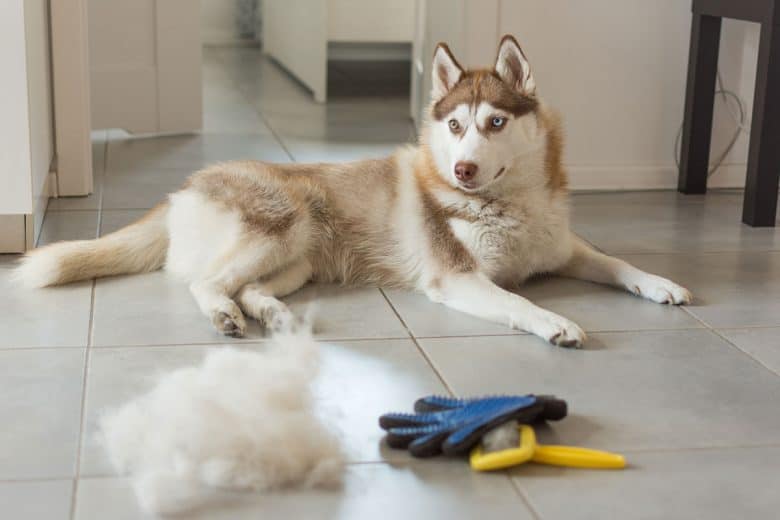
While your Siberian blows her coat, brush her at least once a day. We recommend using an undercoat rake. Finish up with a slicker brush to make her topcoat shine.
When she’s not shedding so heavily, once a week is usually sufficient.
In addition to brushing her fur, you’ll want to brush your Siberian’s teeth 2-3 times a week. Check her ears every week, and trim her nails once or twice a month.
Huskies tend to groom themselves much like cats do, so you won’t (and shouldn’t) bathe your Husky too often. Only shampoo their fur on an as-needed basis to keep it healthy and hydrated.
Don’t Miss Out: 500+ Husky Names
How much should a Siberian Husky eat a day?
Huskies don’t need as much dog food as you might think. 1.5 to 2 cups a day is usually plenty. This may not seem adequate, but remember that Siberian Huskies are bred for a nomadic lifestyle in a harsh environment.
They simply don’t have the same caloric needs as other breeds their size.
Of course, this doesn’t mean they don’t need the same nutrients.
Protein is especially important in the canine diet. Try to feed your Husky dog chow with roughly 20% protein in the summer – up to 32% in the winter when they’re more active.
Limit human food as much as possible, no matter how much of a temper tantrum your Husky throws.
Check out our guide so you can choose what to feed your wolfy pup from some of the best dog food for Siberian Huskies.
Siberian Husky lifespan: How long do they live?
Siberian Huskies are generally healthy dogs, provided they receive the proper care and nutrition.
With an average life expectancy of 12 to 15 years, you’ll be hearing that Husky howl for quite a while to come!
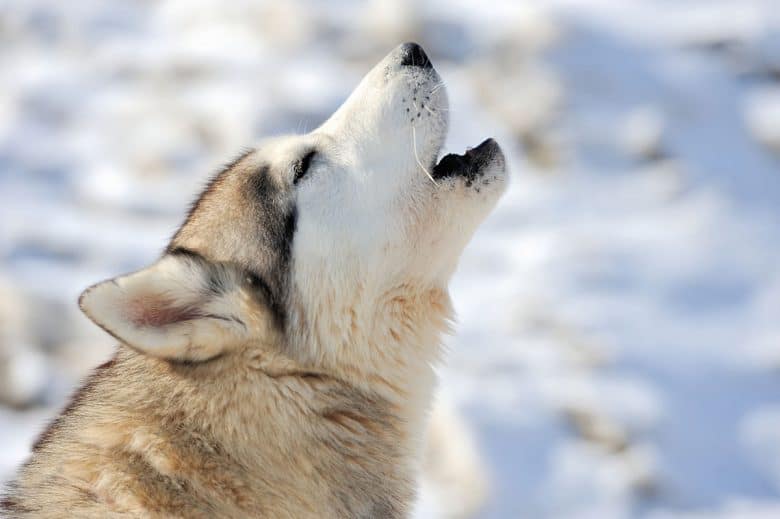
Huskies aren’t without their health risks, however. The most common issues include hypothyroidism, elbow dysplasia, hip dysplasia, and Von Willebrand’s disease.
Siberians are also prone to eye conditions:
- Cataracts often develop gradually as your dog ages. You might notice your Husky’s eyes looking cloudier like a bluish film covers them. This is a telltale sign of cataracts–and a tip-off that you should head to the vet!
- Corneal dystrophy can sometimes look like cataracts, but it’s very different. There are three types of corneal dystrophies, and none of them seem to impair dogs’ vision. Corneal dystrophy also occurs much earlier in a dog’s life than cataracts.
- Progressive retinal atrophy (PRA) is perhaps the most serious of these eye problems. It leads to blindness over time and can appear in puppyhood or adulthood.
There are screening tests for some of these medical conditions, but not all of them. You won’t necessarily know ahead of time if your Husky will have cataracts, for example.
Since you can’t predict every ailment your Siberian Husky will encounter, the best thing to do is try to prevent them.
Brush your Husky’s teeth regularly, and keep them on a healthy diet. This staves off dental problems, obesity, and joint strain.
Did you know that spaying or neutering your Husky is also beneficial for their health? Believe it or not, this common procedure reduces the risks of some cancers. It can also help curb behavioral problems. It’s a win-win!
How Much is a Siberian Husky Puppy?
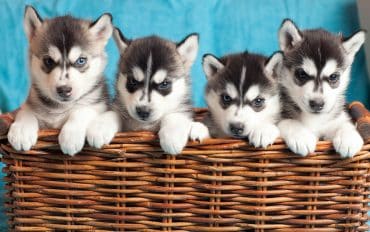 So you’ve decided to buy a Husky of your very own, but now comes the million-dollar question: how much will one of these fluffy puppies cost?
So you’ve decided to buy a Husky of your very own, but now comes the million-dollar question: how much will one of these fluffy puppies cost?
A purebred Husky puppy will set you back at least $600 to $1,500. Some come with price tags closer to the $3000 mark!
The price will depend on the puppy seller, their location, the kennel’s popularity, the parents’ bloodline, and the pup’s availability.
Learn more: Factors that Affect the Price of a Siberian Husky
Siberian Husky breeders & kennels
You shouldn’t have any trouble finding a breeder or kennel with Husky puppies for sale.
On the one hand, that makes your search for the perfect pup incredibly easy. On the other hand, it means you need to be that much more selective when it comes to picking a reputable breeder.
At a bare minimum, Siberian Husky breeders should provide you with specific health clearances. If your breeder doesn’t readily have this documentation, you should start shopping elsewhere. Immediately.
They should have proof of testing from the Orthopedic Foundation for Animals (OFA) for hypothyroidism, hip and elbow dysplasia, and Von Willebrand’s disease.
Clearances from the Canine Eye Registry for ocular health and Auburn University for thrombopathia are also necessary.
An overlooked, but equally important, sign of an experienced breeder is their interest in you and your family. We don’t mean the regular niceties and small talk here.
Rather, the best breeders ask questions about your lifestyle and living situation.
They have a vested interest in how their pups will be treated. If a breeder seems more concerned about making a quick sale, that’s a huge red flag.
For more tips on ethical Husky breeding, we recommend checking out the Siberian Husky Club of America. They have a wealth of information that might be beneficial in making your decision.
In the meantime, you’re probably itching to start your breeder search. Here are a few breeders to kick-start your quest for the perfect Husky:
- Karnovanda Kennels (Davisburg, MI)
- Bama Huskies (Blountsville, AL)
- Loyal Siberian Husky (Hamer, SC)
- Skyler’s Siberians (Lacey, WA)
Adopting a Siberian Husky
Of course, rescuing a Siberian Husky is always an option.
Because of their spunk and quirky personalities, Huskies frequently end up in shelters. It’s not that they’re bad dogs. Some owners underestimate that each breed has specific needs from their humans.
As a result, these canines are surrendered at a higher rate than other breeds.
To find a Husky for adoption, start by scouting out local shelters. If you don’t find any Husky pups at your county humane society, check out breed-specific rescues, like these:
- Pet Harbor Rescue (Bowling Green, VA)
- Free Spirit Siberian Rescue (Harvard, IL)
- Delaware Valley Siberian Husky Rescue (Horsham, PA)
- Southern Siberian Rescue (Raleigh, NC)
If you’re interested in Siberian Husky mixes…
Though they’re great family dogs, Siberian Huskies aren’t for everyone. Luckily, there are designer dogs that are a cross between a Husky and another purebred you like.
Corgi Husky mix (AKA Horgi)
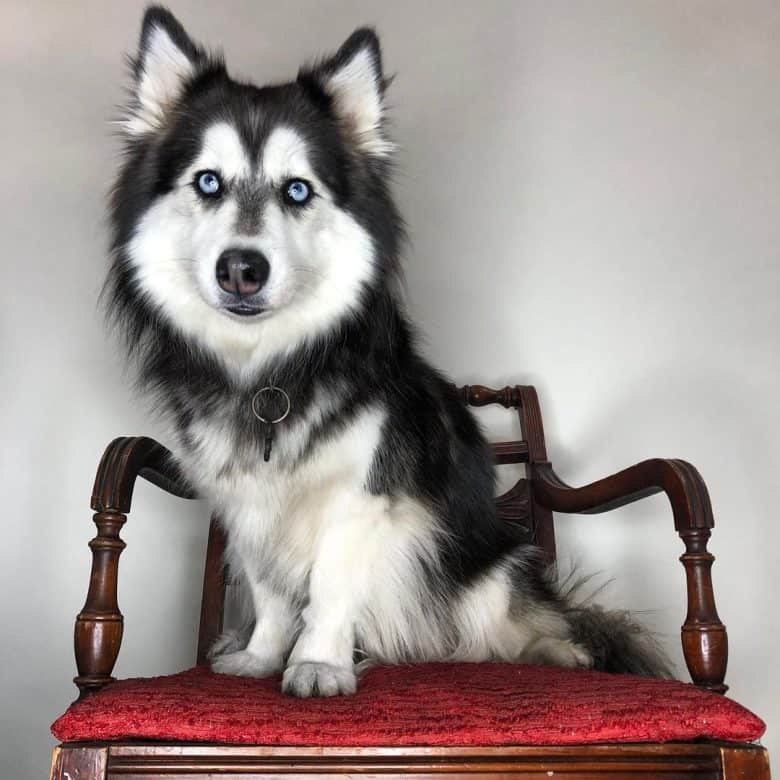
The Corgi Husky Mix is basically a Siberian Husky on a Corgi body. In other words, they’re pretty stinkin’ adorable.
With a more compact build, this crossbreed is easier to manage than purebred Siberians. Consider one of these if you’re worried about the Husky’s size.
German Shepherd Husky mix (AKA Gerberian Shepsky)
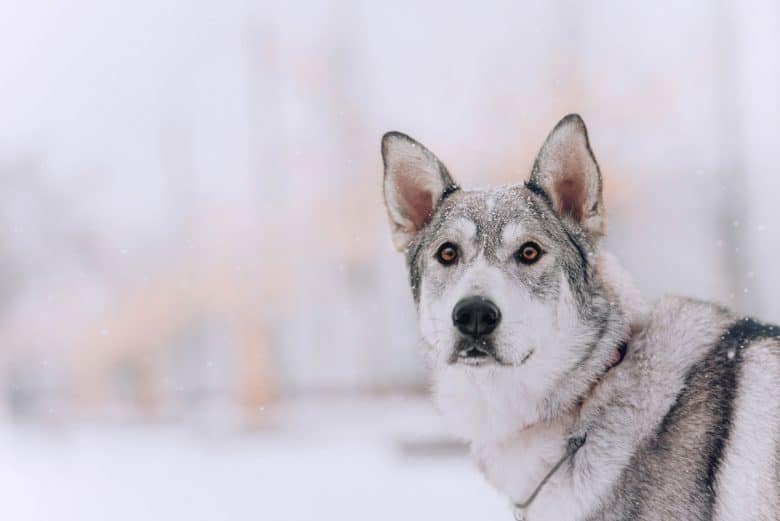
Also known as German Husky, the German Shepherd Husky mix is a hybrid that can serve as a much better watchdog than it’s Husky parent.
Don’t worry, you’ll still be able to enjoy the characteristic Husky awoo–but you’ll also have a reliable guard dog.
Golden Retriever Husky mix (AKA Goberian)
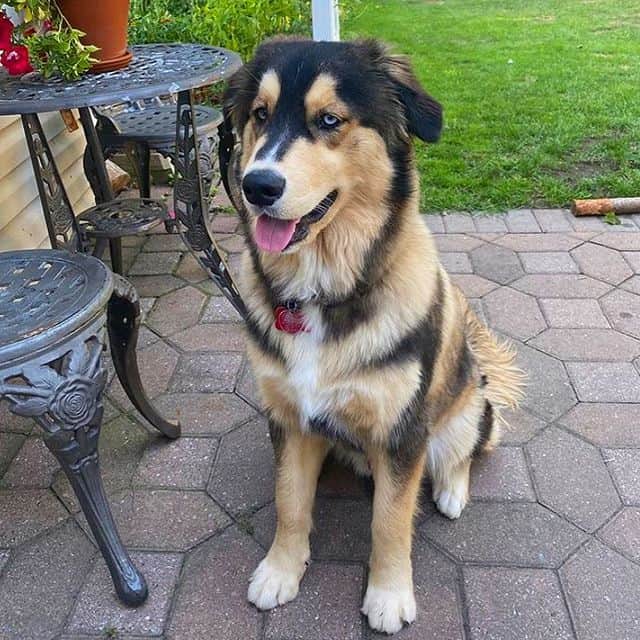
Ah, the good ol’ Goberian! This Golden Retriever-Husky combination is about as friendly as it gets. The Golden’s more docile genes mellow out the Husky’s stubbornness.
If the thought of housebreaking a Husky gives you nightmares, the Gerberian Shepsky may be the dog for you.
Additional Siberian Husky Mixes
- Pitbull Husky Mix
- Pomeranian Husky Mix
- Husky Lab Mix
- Alaskan Husky
- Husky Malamute Mix
- 35 of the Best Husky mixes you need to meet
Who Should Get a Siberian Husky Dog?
We know those blue eyes are captivating, but carefully consider if a Husky is right for you.
For the Pros, Huskies are friendly, loyal, energetic, and clean, and no need to worry about food costs because they don’t require a lot of nom noms. Cha-ching!
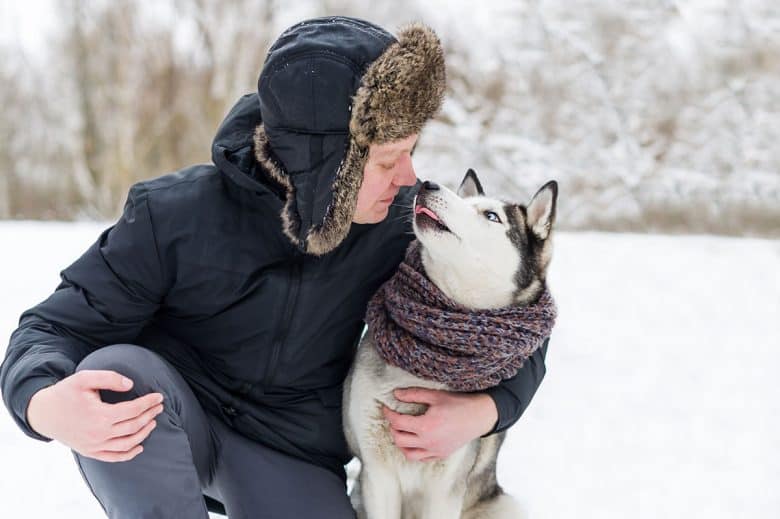
Now the Cons – they’re terrible watchdogs, can be a little too energetic, stubborn and mischievous, and definitely not suitable for first-time owners.
Owning a Husky can be difficult if you’re unprepared, but in the right home, these dogs are nothing short of remarkable.
What do you think of the Siberian Husky now? If you own one and you’d like to share your experiences with your fur baby with those who are interested in this breed, just leave a comment below!
Further Reading: Breeds similar to the Siberian Husky
Like the idea of a purebred Husky but still on the fence? Consider these breeds instead:
Cess is the Head of Content Writing at K9 Web and a passionate dog care expert with over 5 years of experience in the Pet Industry. With a background in animal science, dog training, and behavior consulting, her hands-on experience and extensive knowledge make her a trusted source for dog owners.
When not writing or leading the K9 Web content team, Cess can be found volunteering at local shelters and participating in dog-related events.

I’ve had two Huskys. Nikki and Meka. Meka is still with me. Nikki died of old age long ago. They are my favorite dogs but you must be willing to spend energetic time with them. They are not content to cuddle all day. I found this article to be very accurate but I will say I have 2 cats and Meka, who is now 5 yrs old, has grown up with them and they get along good. The kitties are normally a bit wary around her but have been know to cuddle up a time or two. When I first got her I was worried about the predator / prey but she has always been good to them and I hope this continues. I have always discouraged horse play between her and the kitties. Some people had not been so lucky and you cannot blame the husky, its in their genes. It you want a side kick there better dogs such as labs or retrievers. If you want a friend with his or her own agenda which often coincides with yours if it involves outdoor play then a husky might be in your wheelhouse. Personally I have found huskys to be less enthralled with water than other dogs. When I had a lab and a husky it was the lab who swam and the husky who ran along the beach. Some of them talk more than others and how much you encourage it likely has an effect. We hold long conversations. her and I. But then my kitties also talk with me quite a bit and my family blames it on my encouraging all of them. I enjoy it greatly.